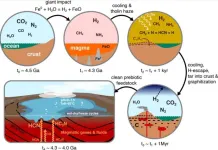(Press-News.org) Twin studies have proven invaluable for teasing out the effects of both genetics and the environment on human biology. In a study published April 2 in Cell Reports, researchers studied pairs of twins to look at how the interplay of genetics and environment affect cognitive processing—the way that people think. They found that some cognitive abilities appear to be regulated more by environmental factors than by genetics.
“Past research has suggested that general intelligence—often referred to as intelligence quotient or IQ—has a heritability ranging from 50% to 80%,” says senior and corresponding author Xiaohong Wan of Beijing Normal University in China. “Our study may be the first to demonstrate that a different kind of cognitive ability, known as metacognition and mentalizing, might be much more influenced by environment.”
Cognitive functions such as perception, attention, memory, language, and planning are considered to be the basis for general intelligence. These functions regulate the way that people organize and process new information. By contrast, metacognition looks at how well people understand and control their cognitive processes.
Metacognition is important for developing learning strategies and is believed to be a predictor of an individual’s successes in school and social achievements. Mentalizing describes the process of recognizing and understanding mental states like emotions and attitudes, both in ourselves and in other people.
For this research, the investigators recruited 57 pairs of adult monozygotic (identical) twins and 48 pairs of dizygotic (fraternal) twins from the Beijing Twin Study (BeTwiSt). This is an ongoing, long-term study established in 2006 that includes extensive data like brain images and psychological surveys, as well as genetic information, on pairs of twins.
The twins were asked to perform tasks related to metacognition. These tasks consisted of watching a cluster of moving dots on a screen and making a perceptual judgement on the net direction of the dots. They were also asked to rate their confidence about their decisions. To measure mentalizing, the participants were asked to evaluate a partner’s confidence in their decision-making abilities.
The investigators found that pairs of twins who had parents with higher levels of education and higher family incomes have similar results to each other, regardless of whether they were identical or fraternal. These observations suggested that familial environment was more likely to influence metacognitive abilities than genetics.
“Our findings were outside our expectations,” Wan says. “Decades of extensive research utilizing the classical twin paradigm have consistently demonstrated the heritability of nearly all cognitive abilities so far investigated. Our findings emphasize that these shared family environmental factors, such as parental nurturing and the transmission of cultural values, likely play a significant role in shaping the mental state representations in metacognition and mentalizing.”
The researchers acknowledge that there are limitations to this research and that many more studies are needed. They plan to continue their research in this area, including using population studies to further investigate what kind of specific parental nurturing factors and sociocultural values affect individuals’ metacognitive and mentalizing abilities.
###
This research was supported by the Ministry of Science and Technology of the People’s Republic of China, the National Natural Science Foundation of China, the Interdisciplinary Innovation Team of the Chinese Academy of Sciences, and the BeTwiSt of Institute of Psychology, Chinese Academy of Sciences.
Cell Reports, Jiang et al. “Distinct Genetic and Environmental Origins of Hierarchical Cognitive Abilities in Adult Humans” https://cell.com/cell-reports/fulltext/S2211-1247(24)00388-7
Cell Reports (@CellReports), published by Cell Press, is a weekly open-access journal that publishes high-quality papers across the entire life sciences spectrum. The journal features reports, articles, and resources that provide new biological insights, are thought-provoking, and/or are examples of cutting-edge research. Visit: http://www.cell.com/cell-reports. To receive Cell Press media alerts, contact press@cell.com.
END
LA JOLLA (April 18, 2024)—Salk Institute Professor Satchidananda Panda has been named a 2023 Fellow of the American Association for the Advancement of Science (AAAS), the world’s largest general scientific society and publisher of the journal Science. Panda is among 502 new AAAS Fellows spanning 24 scientific disciplines who were nominated by their peers for their distinguished efforts to advance science. The election recognizes his contributions to the field of chronobiology, particularly for applications to obesity and human health.
“The Salk community congratulates ...
A new urine test that measures 18 genes associated with prostate cancer provides higher accuracy for detecting clinically significant cancers than PSA and other existing biomarker tests, according to a study published April 18 in JAMA Oncology. The urine test, MyProstateScore 2.0 (MPS2), was shown to meaningfully reduce unnecessary prostate biopsies while providing highly accurate detection of worrisome prostate cancers, the researchers concluded.
“In nearly 800 patients with an elevated PSA level, the new test was capable of ruling out the presence of clinically significant prostate cancer with remarkable accuracy. This allows patients to avoid more burdensome and ...
Milan, April 17 2024 – The study, published in Nature Energy, is among the first to explore the FPV at the continental scale, finding that FPV installed at existing major reservoirs could produce 20-100% of the electricity expected from Africa’s planned hydropower dams. Using a state-of-the-art energy planning model covering the continent’s entire energy system, the researchers found that FPV is cost-competitive with other renewables and thus a key part of Africa’s future energy mix.
"Floating solar is fast becoming cost-competitive with land-based solar, and ...
Scientists in Cambridge University suggest molecules, vital to the development of life, could have formed from a process known as graphitisation. Once verified in the laboratory, it could allow us to try and recreate plausible conditions for life's emergence.
How did the chemicals required for life get there?
It has long been debated how the seemingly fortuitous conditions for life arose in nature, with many hypothesises reaching dead ends. However, researchers at the University of Cambridge have now modelled how these conditions could occur, producing the necessary ingredients for life in substantial ...
A geo-environmental scientist from Japan has composed a string quartet using sonified climate data. The 6-minute-long composition—entitled “String Quartet No. 1 “Polar Energy Budget”—is based on over 30 years of satellite-collected climate data from the Arctic and Antarctic and aims to garner attention on how climate is driven by the input and output of energy at the poles. The backstory about how the composition was put together publishes April 18 in the journal iScience as part of a collection “Exploring the Art-Science Connection.”
“I strongly hope that this manuscript marks a significant turning point, transitioning ...
A new ancient species of snake dubbed Vasuki Indicus, which lived around 47 million years ago in the state of Gujarat in India, may have been one of the largest snakes to have ever lived, suggests new research published in Scientific Reports. The new species, which reached an estimated length of between 11 and 15 metres, was part of the now extinct madtsoiidae snake family, but represented a distinct lineage that originated in India.
Debajit Datta and Sunil Bajpai describe a new specimen recovered from the Panandhro Lignite Mine, Kutch, Gujarat State, India, which dates ...
About The Study: The findings of this study with 322 participants suggest that racial discrimination predisposes Black young adults to metabolic syndrome via sleep problems and inflammation, which may serve as actionable targets for prevention in minoritized populations that could reduce existing disparities and promote health equity.
Authors: Nia Heard-Garris, M.D., M.B.A., M.Sc., of the Northwestern University Feinberg School of Medicine in Chicago, is the corresponding author.
To access the embargoed study: Visit our For The Media website at this link https://media.jamanetwork.com/
(doi:10.1001/jamanetworkopen.2024.5288)
Editor’s Note: Please ...
About The Study: In this cross-sectional study using data from the Behavioral Risk Factor Surveillance System for 10,000 cancer survivors, only 4% of cancer survivors adhered to all four American Cancer Society nutrition and physical activity guidelines, with the mean number of guidelines met being 2.0. Improved understanding of guideline adherence and its determinants may guide oncologists and general internists in providing recommendations for their patients who have completed cancer treatments.
Authors: Kathryn Norman, M.D., of the Beth Israel Deaconess Medical Center in Boston, is the corresponding author.
To access the embargoed study: Visit our For The ...
ANN ARBOR, Michigan — Researchers at the University of Michigan Rogel Cancer Center have developed a new urine-based test that addresses a major problem in prostate cancer: how to separate the slow-growing form of the disease unlikely to cause harm from more aggressive cancer that needs immediate treatment.
The test, called MyProstateScore2.0, or MPS2, looks at 18 different genes linked to high-grade prostate cancer. In multiple tests using urine and tissue samples from men with prostate cancer, it successfully identified cancers ...
Findings of substantial variability in pathology AI models’ performance based on race, insurance type and age group serve as a “call to action” to researchers and regulators to improve medical equity
Large foundation models that incorporate a richer level of detail may mitigate disparities between different demographic groups and enhance model accuracy.
Advanced artificial intelligence (AI) systems have shown promise in revolutionalizing the field of pathology through transforming the detection, diagnosis, and treatment of disease; however, the underrepresentation of certain patient populations in pathology ...




